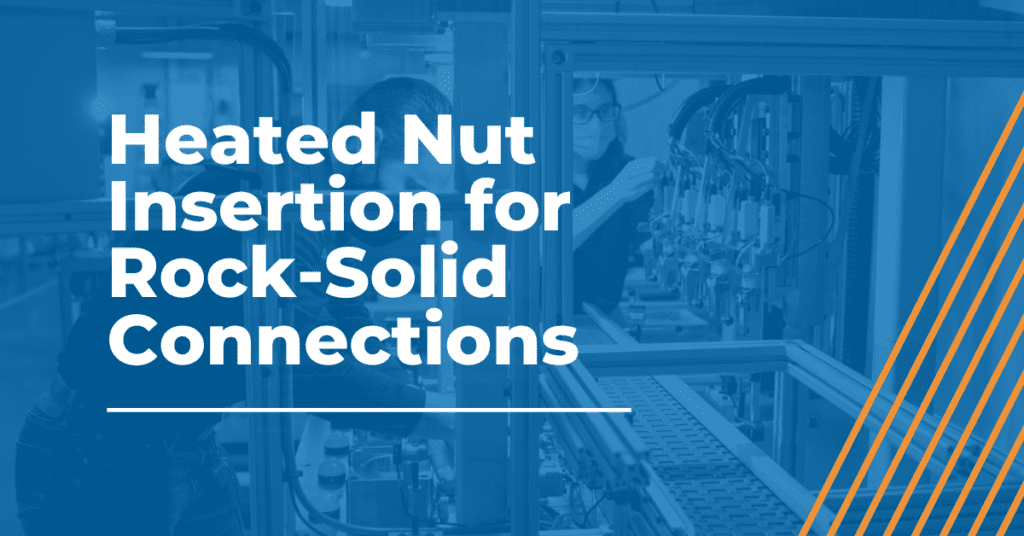
Heated Nut Insertion Automation Streamlines the Manufacturing Process
Whether it’s for an intake manifold, surgical light or lawn mower deck, attaching perfectly molded plastic parts to the rest of a sub-assembly can be a struggle. Fortunately, you can overcome that obstacle with precision heated nut insertion.
Manufacturers across the automotive, medical device manufacturing and consumer product industries benefit from automating the nut insertion process. At AMS, our proprietary nut insertion automation process positions nuts within 0.02 mm of target and ensures that each and every nut is inserted at a depth that meets specifications.
Why Heated Nut Insertion?
The three technologies commonly used for hot nut insertion include inductive heating, conductive heating and ultrasonic insertion. Inductive hot nut insertion heats the nut in a magnetic field produced by an inductive coil. Conductive heating is the process of either preheating the insert, or placing a insert on the end of a heated tooling element and waiting for the thermal transfer of energy from the tool to the insert to take place before insertion into the plastic. Ultrasonic insertion uses a sonotrode that contacts the insert directly to generate heat through high frequency friction.
Induction heating is the preferred process because it is quick, clean, quiet and precise. Although understanding the interplay of multiple complex variables including coil geometry, coil material, heat time, coolant supply, insertion force, insertion velocity and final depth settings can feel intimidating, our team can help you tackle these challenges. We will help you fine tune these parameters to consistently position nuts according to your customers’ application requirements.
Additional benefits of heated nut insertion automation include:
- Ability to use multiple actuation mechanisms including: Air cylinders, servo actuators, and various robotic solutions.
- Each nut is placed at the appropriate depth so that it is flush to 0.02mm proud with the receiving surface.
- Customized solutions provide short cycle times to meet your customers’ speed cycle requirements.
Drawbacks to Consider
Our team has found notable shortcomings to both conductive heating and ultrasonic insertion. Conductive heating is slower than induction heating and creates a safety risk due to operator exposure to hot tooling. Ultrasonic insertion is limited to one 1 Z-plane insertion depth, and has a need for constant cleaning (due to chipped metal particles that flake off the nuts). Ultrasonic nut insertion can also be uncomfortable for operators: The process is so loud that workers are required to use hearing protection.
Engineered Resins and Nut Insertion
We’re seeing more highly engineered resins, which are designed for specific performance requirements. Although resins can be modified to enhance a variety of performance characteristics, each resin modification impacts secondary processing. We work with customers to modify resins for their specific needs. For example, we add stiffeners, like glass or talc, to make resins stronger. Each time we modify a resin to enhance its performance, we design a custom approach to optimize the heated nut insertion automation process.
Automation Works to Meet Specs
When you think of nut orientation, consider the X, Y and Z axes. At AMS, a unique mechanical pick-up mechanism and robotic automation enable us to place every nut within 0.02 mm of target. Not only is this helpful for placement in the X and Y planes, but we also automate the process for placement along the Z axis or, more specifically, how much pressure to apply to make sure the nut is flush with the surface.
Our nut insertion automation also eliminates unintended flash. When every nut insertion is clean, no displaced resin will show up in unwanted places on your part.
Flush Surfaces Improve Performance
Another benefit to automated heated nut insertion: It ensures that each nut is installed at precisely the right depth. A completely flush surface is vitally important in highly engineered applications that are part of safety systems. An automotive mass air flow sensor is an example of one component of a car’s safety system. In this application, nuts need to be flush with the surface or they will generate inaccurate readings from the mass flow sensor.
Questions on Heated Nut Insertion?
To learn more about automated nut insertion, download our white paper “Induction Heated Nut Insertion,” view our nut insertion automation video below or contact us to discuss your upcoming needs.
We look forward to helping you conquer your nut insertion automation challenges.
Our Automated Medical Manufacturing White Paper Will Help You Envision New Ways of Operating
Reading this white paper will help you:
